Tuesday, 26 February 2019
An In-depth Look into an Inquiry
9:36 pm
Our current inquiry is centered around the question – “What is the impact of home being taken away?”Students have been immersed in reading and writing experiences dealing with the topics of homelessness, refugees and residential schools. My goal is for students to gather important information on these topics so they can write about them with knowledge and empathy. Thinking about how writers engage the hearts and minds of their readers is woven throughout this study.
Below is a sampling of these experiences:
 |
| Images to spark thinking. |
Here are three images related to our study. Students used the “See Think Wonder” thinking routine. They listed their observations, thoughts and questions about the photos. This allowed them to think critically about the images and try to figure out how they might be related to our inquiry.
Students then worked in small groups to sort out and arrange the words to form our central question – “What is the impact of home being taken away?”
 |
| Sorting our central question. |
With the topic of our inquiry at the forefront of their minds, students were able to construct three words, two questions and one metaphor or simile describing what it would be like to not have a home. Check out two videos of students sharing their thinking below.
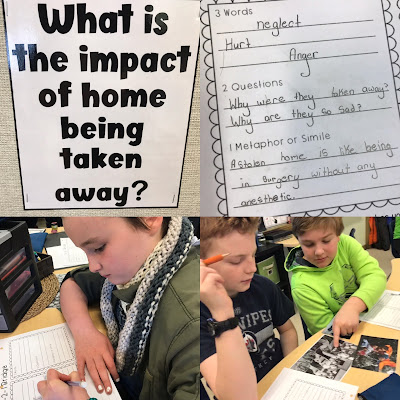 |
| 3-2-1 Bridge Thinking Routine. |
Our read aloud is Refugee by Alan Gratz. This book is a fantastic complement to our study. Students find all three stories in this text extremely engaging. Each action-packed story is told from the perspective of a child refugee fleeing their countries for a better life.
We have also read many different picture books and watched videos throughout our study and we continue to do so. Our discussions of these texts have been emotional and meaningful. Students are making deep connections between these multiple books. This helps to develop critical thinking.
 |
| Some of the many texts used in this study. |
Sometimes I like to have students look at parts of a story before reading the picture book in full. We did this for the story, “I am Not a Number” by Jenny Kay Dupuis. Below, students are viewing an image from the story. They are discussing and recording everything they see, think and wonder about.
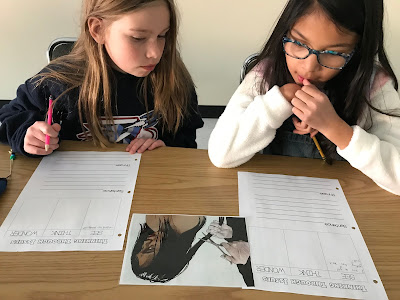 |
| Thinking about an image from a text prior to reading the book. |
Afterwards, I read the story to the class as a whole group. Students revisited their image and this time read the snippet of text that went along with their image. They were able to discuss the text together bringing greater understanding to the specific image in front of them. Students also worked through another thinking routine called “Sentence Phrase Word”. They had to select one sentence, phrase and word that captured the overall essence of the text. Listening to students explain their reasons for their selections is a great way to assess their critical thinking skills.
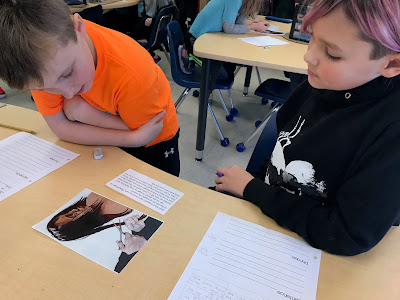 |
| Adding the text to the image and sharing thinking further. |
Like I stated in the beginning, we are constantly discussing what good writers do. We will read a story as a reader by focusing on the meaning and how the writing made us feel. Then we will also look at it with the lens of a writer, noting the different craft moves that held our attention and made the writing sound so amazing that you don’t want to put the book down. See below.
 |
| Charting the craft moves found in the book - Feathers. |
 |
| Anchor chart of What Good Writers Do. |
 |
| Chart inside a student's writer's notebook. |
Students are very interested in these issues because they represent real life. However, this inquiry topic is also a heavy one. Therefore, I felt it was important to add “light” within this study. We discussed how fortunate we are to have a “sense of place” or that feeling of home. One of our writing projects is to write about the meaning of home and how it is an integral part of our lives. I had students create a collage board or a vision board of their special place and this supported them when drafting their writing. I even wrote about my special place in front of students. They were able to see me think out loud, craft a variety of sentences, organize my thoughts in paragraphs, re-read my work, etc.
 |
| A student vision board of his favourite place that feels like home. |
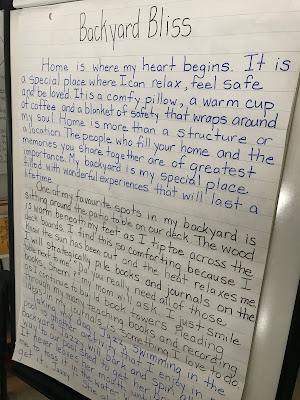 |
| My writing about my special place. |
Students have been working on their home pieces in their writer’s notebook and we will be completing final copies soon. I have been celebrating each writer by pointing out all the great things they are doing in their writing. A public conference allows for all learners to hear great ideas that they may apply to their own pieces. I have had audience members record their thinking on post-its to capture what they have learned. This makes everyone accountable.
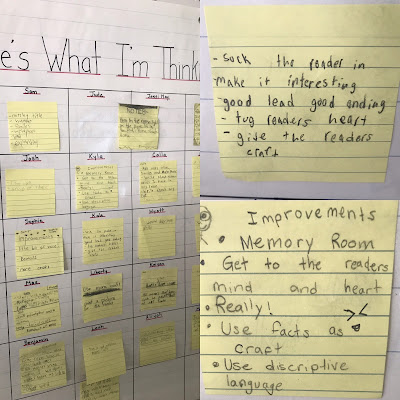 |
| Student post-its written during a public conference. |
 |
| A public conference in action. |
Here are some samples of student writing below.
Currently, students are researching residential schools and refugees (see below). They will use their research to write an informative piece on one of these topics soon.
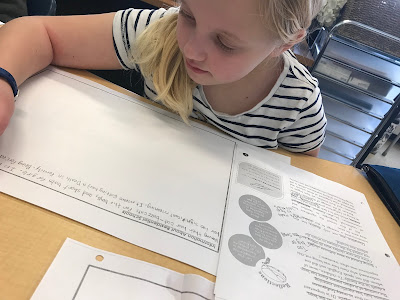 |
| Student collecting research on residential schools. |

Tuesday, 28 November 2017
Got Grit?
8:23 pm
We have been reading articles and picture
books as well as viewing various videos that deal with the theme of GRIT. Grit is
basically giving it your all and not giving up in the face of obstacles. It is
about working hard to achieve your goals. I want students to have a “gritty
attitude” so that they meet life’s challenges with courage, determination and
perseverance. This also applies to the challenges of learning that they face in
the classroom. Grit is a life skill that will serve them well as they continue their academic journey, all the way through to adulthood.
My plan is to use this theme as a stepping-stone for an inquiry into citizenship and human rights that will take place in January.
My plan is to use this theme as a stepping-stone for an inquiry into citizenship and human rights that will take place in January.
Below is a sampling of
some of our frontloading experiences:
Students were given several words and were asked to define them.
Together they had to discuss what they all had in common. In the end, students
discovered that all of these words are related to one another and deal with GRIT.
Various books with the underlying theme of grit were read aloud to students. Here, they used the strategy “stop and jot” to
record thinking on post-its.
We watched several videos or short clips on youtube that dealt with grit. Angela Duckworth's Ted Talk - Grit: The Power of Passion and Perseverance is excellent.
We recorded our findings about grit (from books and videos) in our notebooks:


Students interviewed a parent to learn about how they used grit in their lives. This experience was very valuable. We included our families on the discussion and students got to hear a variety of stories that added to their understanding of grit.


I wrote about a "grit moment" from my own life:
Students analyzed articles about people who worked through difficult times or worked hard in order to achieve success in their lives. The example below is a response after reading an article about the NHL player, Mark Scheifele, who plays for the Winnipeg Jets.
We generated a list of criteria for students to use in their own written pieces on grit.
While all of these experiences were taking place, we were also focusing on what great writers do. I decided to teach students a "craft move" that we have called Action Clues. This technique slows down your story, builds tension and allows the reader to feel the emotion.
I revised my piece to make it more interesting for the reader. I originally had a bit of this already with the line - "Right near the end, at about mile 12, my legs were blocks of cement and I felt numb." I wanted to extend this feeling and give more clues for the reader. So I added - "My body ached and sweat dripped into my eyes. I felt dizzy with exhaustion. My head was heavy and I wasn't sure if I could do it."


We recorded our findings about grit (from books and videos) in our notebooks:


Students interviewed a parent to learn about how they used grit in their lives. This experience was very valuable. We included our families on the discussion and students got to hear a variety of stories that added to their understanding of grit.


I wrote about a "grit moment" from my own life:
Students analyzed articles about people who worked through difficult times or worked hard in order to achieve success in their lives. The example below is a response after reading an article about the NHL player, Mark Scheifele, who plays for the Winnipeg Jets.
We generated a list of criteria for students to use in their own written pieces on grit.
I revised my piece to make it more interesting for the reader. I originally had a bit of this already with the line - "Right near the end, at about mile 12, my legs were blocks of cement and I felt numb." I wanted to extend this feeling and give more clues for the reader. So I added - "My body ached and sweat dripped into my eyes. I felt dizzy with exhaustion. My head was heavy and I wasn't sure if I could do it."
We also looked at this craft move in different texts. I like to use short passages from novels as well as picture books. This allows students to see a technique modelled multiple times in literature. Here is an example below:
"Jerry sat on his bed and I could tell that he was losing his fight to not cry. Tears were popping out of his eyes and slipping down his cheeks." (Bud, Not Buddy by Christopher Paul Curtis)
Students also experimented with this technique in their notebooks. They took a plain sentence and turned it into something interesting for the reader:
 |
| "Terry jumped up and down. His brain was filled with questions. His heart was pumping fast, his eyebrows were raised and his eyes lit up because it was the final game in the hockey tournament." |
With all of this intentional front-loading, students were ready to write about their own "gritty" moment.
Here is one student's draft:


I am so proud of my students' writing. Frontloading, writing with a purpose, using topics that interest students, being authentic and consistently discussing what good writers do all help pave the way for successful writing!

Subscribe to:
Comments
(Atom)
Popular Posts
-
We have been discussing how important it is to be a responsible user of technology - especially when online. I decided to show a video crea...
-
We have been working very hard this week getting back into the swing of things. I decided to read the story, Finding the Green Stone by Al...
-
We continue to discuss and analyze a variety of texts as a whole class, in small groups and individually. I want students to read a text us...
-
Studying the work of various authors is an important component to my writing program. As a young girl, I loved reading these little boo...
-
To begin our inquiry, we read a wide variety of books (picture books, chapter books and non-fiction) to get us thinking and to allow thoug...
-
Recently, I found a wonderful idea via Twitter! Someone posted a photo of parents filling out a paper tweet to show support for their child...
-
Explain Everything is the perfect tool to capture students' thinking. I wanted students to assess their dream writing by taking photog...
-
I can’t believe it! In two days, Regie Routman will be in my classroom for a weeklong residency at Strathmillan School! I am so...
-
The 2014 Sochi Winter Olympics is now over, however, our inquiry, "Going for Gold", continues! We have been reading many books an...
-
How can I create a caring, nurturing environment for all of my students while meeting their individual needs? Through art and writing of c...
Powered by Blogger.




















